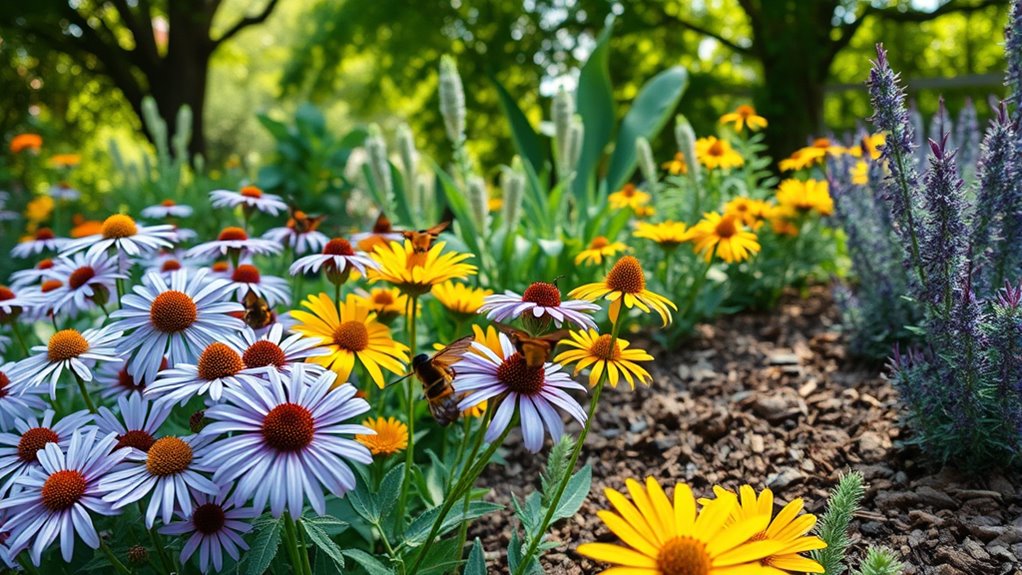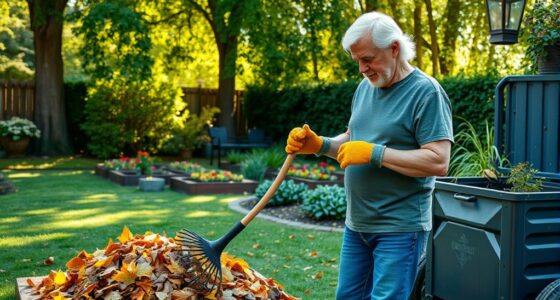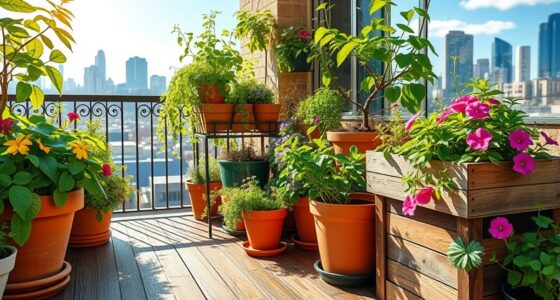To create a pollinator-friendly, low-allergen garden, choose native plants like coneflowers, black-eyed Susans, and milkweeds, which attract pollinators and produce less airborne pollen. Incorporate showy flowers like certain salvias that draw beneficial insects without increasing allergy risks. Avoid highly allergenic species such as grasses and certain trees, and maintain your garden regularly. Keep exploring for more tips on selecting plants that support pollinators while keeping allergies to a minimum.
Key Takeaways
- Prioritize native plants like coneflowers, black-eyed Susans, and milkweeds, which attract pollinators and produce less airborne pollen.
- Select showy, nectar-rich flowers such as certain salvias and butterfly bushes bred for low allergenicity to support pollinators without increasing allergies.
- Incorporate diverse plant species and native wildflowers that provide ample nectar while minimizing allergenic pollen dispersal.
- Avoid high-pollen producers like grasses and certain trees; plant in less-used outdoor areas to reduce allergen exposure.
- Regularly maintain and deadhead flowers to decrease pollen dispersal and create a healthier, pollinator-friendly garden environment.

Creating a garden that supports pollinators while minimizing allergy risks is achievable with careful plant selection. You can enjoy the beauty and benefits of a vibrant garden without compromising your health by choosing the right plants. Many native species attract bees, butterflies, and other pollinators, but some also produce pollen or fragrances that can trigger allergic reactions. To strike a balance, focus on plants known for their pollinator friendliness and low allergenic potential. Start by researching native plants in your region, as they tend to be less likely to cause allergies and are naturally appealing to local pollinators. Think about incorporating flowers like coneflowers, black-eyed Susans, and milkweeds, which offer nectar and pollen without overwhelming fragrances or excessive airborne pollen. These plants typically produce pollen that’s heavy and sticky, making it less likely to become airborne and cause allergic reactions.
In addition, consider plants with showy flowers that don’t produce much airborne pollen. For instance, butterfly bushes and certain salvias are excellent choices—they attract pollinators with their nectar-rich blooms and tend to have minimal pollen dispersal. You might also explore cultivars specifically bred for low allergenicity; these varieties often have reduced pollen production or flower structures that limit pollen release. When planting, opt for strategies that help reduce allergen exposure, such as planting in areas away from frequently used outdoor spaces or wearing masks during peak bloom times. Avoid species that produce large amounts of airborne pollen, like grasses or certain trees, which are notorious for triggering allergies.
Supporting pollinators doesn’t mean you have to sacrifice your well-being. Many low-allergen plants still provide ample nectar and pollen for beneficial insects. Consider adding plants with tubular flowers, as they often produce nectar that attracts hummingbirds and butterflies without releasing significant pollen into the air. Native wildflowers are also a smart choice—they’re adapted to your environment and tend to be less allergenic while still supporting local pollinators effectively. Additionally, selecting pollinator-friendly plants with low allergenicity can help create a balanced garden environment. Regularly removing seed heads and deadheading flowers can help minimize pollen dispersal indoors and keep your garden cleaner. Remember, a diverse garden with various plant types not only supports a wider range of pollinators but also reduces reliance on any one allergenic species.
Frequently Asked Questions
How Do I Identify Pollinator-Friendly Plants in My Region?
To identify pollinator-friendly plants in your region, start by researching native species that thrive locally. Look for plants with vibrant, nectar-rich flowers and diverse bloom times throughout the season. Visit local botanical gardens or talk to gardening experts for regional tips. Additionally, check plant tags or labels for pollinator-friendly symbols or descriptions, and observe which plants attract bees, butterflies, and other pollinators in your area.
Are There Native Plants That Are Also Low Allergen?
Yes, many native plants are also low allergen, offering a dual benefit for your garden and health. Imagine walking through a lush landscape where pollinators thrive and sneezing is rare. You might consider plants like coneflowers, black-eyed Susans, and bee balm. These native beauties attract pollinators and are less likely to trigger allergies, making your outdoor space both vibrant and comfortable.
How Can I Balance Pollinator Needs With Allergy Concerns?
To balance pollinator needs with allergy concerns, choose plants that are native and low-allergen, like coneflowers or bee balm, which attract pollinators without triggering allergies. Plant a diverse mix to support different species and reduce reliance on highly allergenic plants. Position your garden away from frequently used outdoor areas, and consider implementing barriers or planting in containers to minimize allergen exposure while still supporting pollinators.
Do These Plants Require Special Soil or Watering Conditions?
Most of these plants thrive in well-drained soil and require moderate watering. You should check each plant’s specific needs, as some prefer slightly acidic or alkaline soil, while others grow best in loamy or sandy conditions. Water them regularly but avoid overwatering, which can lead to root rot. Keep the soil consistently moist during the growing season, and adjust watering based on weather and soil moisture levels.
Can I Use These Plants in Container Gardening?
Imagine your container garden as a tiny, thriving ecosystem. Yes, you can use these plants in containers; they adapt well and bring vibrant life to small spaces. Just make certain you select the right size pots, use well-draining soil, and water consistently. Think of each plant as a symbol of harmony—attracting pollinators and reducing allergens—creating an inviting, lively corner that celebrates nature’s beauty right at home.
Conclusion
Think of your garden as a bustling marketplace, where pollinators are the enthusiastic shoppers and your plants are the vibrant stalls. By choosing pollinator-friendly, low-allergen plants, you become the wise merchant guiding a diverse crowd safely and happily. Your garden then becomes a harmonious symphony, thriving with life and kindness. When you plant thoughtfully, you’re not just growing flowers—you’re nurturing a delicate web of connections that sustains and enriches your entire community.









